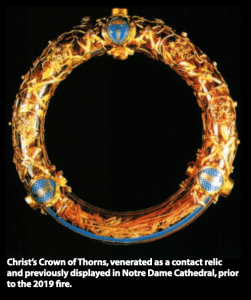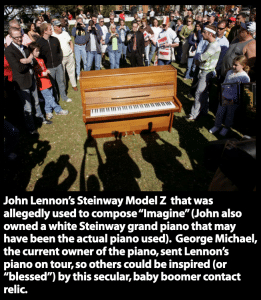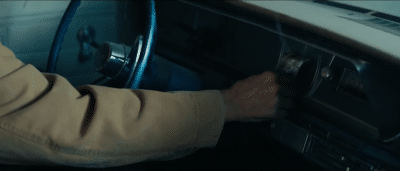Before anything else, (re) watch Chevy’s latest Christmas ad.
Music Sets the Stage
Note that the ad opens with soulful guitar music, heavily reminiscent of the musical theme “Story Book Love” from A Princess Bride.
[If you don’t recall that music, click here and go to the 1:09 mark]
Dropped in the Middle of a Ritual
 As we observe the old man exit his home and walk to the barn, wreath in hand, we quickly realize we’ve been dropped into the middle of a ritual.
As we observe the old man exit his home and walk to the barn, wreath in hand, we quickly realize we’ve been dropped into the middle of a ritual.
How do you know it’s a ritual?
Because he’s taking down an old wreath and placing a new one on the door.
So placing a wreath on the door is a repeated activity. His actions are neither rushed, nor casual, but rather slowly done with great intention and care.
 We know it’s a ritual because of the solemnity which envelops the action. The man places the wreath upon the door the way one would place flowers on the grave — though first-time viewers haven’t consciously made that connection yet.
We know it’s a ritual because of the solemnity which envelops the action. The man places the wreath upon the door the way one would place flowers on the grave — though first-time viewers haven’t consciously made that connection yet.
And once he gets inside the barn, we realize the wreath replacement has been repeated many times as the man lays the old wreath on a stack of old wreaths.
Still, there’s a mystery: why is he engaging in this ritual with such sadness?
Who or what is he commemorating?
This mystery keeps us watching.
Contact Relics and Commemorating the Lost
 Then there’s the car, which, though dusty, is lovingly caressed.
Then there’s the car, which, though dusty, is lovingly caressed.
Now, the car could have represented a relic from the man’s youth, or from a now-absent child (either absent from distance or emotional estrangement, or death).
But the car is clearly, powerfully attached to something from the past that the man longs for.
And to understand this, we have to abandon rational materialism to understand the mystical bonds between people and their stuff.
 Think of Contact Relics in the Catholic Church.
Think of Contact Relics in the Catholic Church.
People normally think of relics as Saints’ bones or remains. But objects that a saint owned or meaningfully interacted with frequently count as contact relics.
Among the most famous contact relics is the ring of thorns with which Jesus was crowned — a relic previously housed in Notre Dame and saved from the 2019 fire.
And this religious sentiment (aka, Magical Thinking) isn’t limited to the religious.
Everyone’s mind works like this, both consciously and subconsciously.
It’s why sports and movie and historical memorabilia is a multi-billion dollar industry.
The greater the emotion between a human and an owned object, the greater the connection. That’s why book collectors pay more for signed first editions.
 A recent example of “contact relics” in secular culture is the tour of John Lennon’s Piano. The same piano he allegedly used when composing “Imagine.”
A recent example of “contact relics” in secular culture is the tour of John Lennon’s Piano. The same piano he allegedly used when composing “Imagine.”
People felt more spiritually connected to John and everything he and his music (and perhaps the Beatles) represented when playing that piano as it toured the country.
And this magical connection between owner and object works in the opposite direction as well: no one wants to live in the former home of a serial killer.
So this car powerfully represents its owner to the man. But who owned the car?
Semiotics. Showing What’s Not There
You can either compare and contrast with a before and after — show the element present, then show the effects of its absence.
Or you can use semiotics — you can have a stand-in symbol for what’s missing.
 For this Chevy commercial, they used the “wallet” picture as a symbol for the man’s wife. We learn from the picture, who this car really belongs to, and who the wreath is meant to honor.
For this Chevy commercial, they used the “wallet” picture as a symbol for the man’s wife. We learn from the picture, who this car really belongs to, and who the wreath is meant to honor.
And note the physical connection between the picture and the car — the picture is kept IN the car, up on the dash, furthering the psychological connection between the car to its late owner.
Then we see the memories and really get filled in.
Shifting Perspective, Adding Hope & Comfort
 As soon as we get full understanding of the ritual and its meaning, such that our heart aches for the man on the screen, the perspective shifts to the daughter.
As soon as we get full understanding of the ritual and its meaning, such that our heart aches for the man on the screen, the perspective shifts to the daughter.
Literally, we move from standing over the shoulder of the man and even looking through his eyes at memories past, to looking at the man from the perspective of the daughter, quietly observing her dad’s grieving from the porch.
We understand he’s not hurting all alone. He still has family.
 The music shifts too, moving to sound a bit reminiscent of “Somewhere Over the Rainbow” when the song hits the “Someday I’ll wish upon a star” portion (about 44 seconds in).
The music shifts too, moving to sound a bit reminiscent of “Somewhere Over the Rainbow” when the song hits the “Someday I’ll wish upon a star” portion (about 44 seconds in).
This is when the symbolic action shifts into higher gear, as daughter decides to pay to restore her mom’s car to its former glory, both as a present for dad and a tribute to her mother.
The daughter moves from idea to action when she enlists the help of the dad’s friends, who conspire to keep the restoration a surprise.
Again, the man is not mourning alone. He not only has family but community.
And through the daughter’s interaction with the restoration crew, we learn more about the meaning of the car to the daughter.
Coming Full Circle & Symbolic Action — One Relic Deserves Another
The car is lovingly restored back to its former glory.

And then we return to the opening ritual, with the man going out to change the wreath, bringing the story full circle, allowing us to experience the change in full.
When the man ceremonially opens the car door, we see not grief but wonder as his eyes take in the gleaming, glowingly restored Chevy convertible.
Yet it is not just the car that has been restored.
The picture inside the car has also been properly framed, protected, and dignified.
It is now, in fact, hung from the rearview mirror in the way some Catholics hang a Rosary or Anglicans will hang a Saint Christopher (patron saint of travelers) medal.
 And whereas the old ritual kept the car “dead,” the revised ritual ends with the man bringing the car to life, turning the key, and reveling in the sound of the engine.
And whereas the old ritual kept the car “dead,” the revised ritual ends with the man bringing the car to life, turning the key, and reveling in the sound of the engine.
He then drives the car up to the house where the daughter receives his thanks and proclaims, “it’s what mom would have wanted.”
End credits as Dad, Daughter, and family dog drive into the sunset with Chevy wishing the viewer a Happy Holidays.
How This Helps Chevrolet
One of the many messages of this mini-movie is that the material things of our lives can be (and often are) deeply meaningful.
And this goes double for those things normally tied up with identity, such as cars.
Cars are not just appliances designed to get us from point A to point B. They are not just status symbols or social signals.
Not a bad message for a car manufacturer
Further to this point, the commercial also shows that Chevrolet is one manufacturer that “Gets” that.
Chevrolet is also an American icon, a car brand most easily associated with this small, poetic slice of Americana.
So while there is no overt selling message to this ad — nor should there be, as this would only harm the purity of emotion — you can’t watch this mini-drama without feeling more warmly about Chevy.
Your love for this small piece of commercial art, which you’ll most likely demonstrate by sharing the ad with others, can’t help but partially rub off onto Chevy, even if only at a subconscious level.
And what more could you ask for from a branding ad?
Some Take-Aways for Your Advertising
Lesson 1: Speak to Meaning, not Features and Benefits
Do you think 99.9% of viewers cared one bit that the car featured in the ad was a 1966 Impala?
Or wondered whether it was powered by a small or large block V-8? Or what kind of transmission it had?
Hell, no.
When you speak to symbolic meaning over specs, your ads become more relevant, relatable, and likable.
When you focus too narrowly on reason-why differentiators and features, your ads run the risk of becoming petty to the point of irrelevance.
Chevy’s branding in this ad focused on meaning — and so too should your branding ads.
Meaning is magical, and in this, understanding the rules of magical thinking can bring added magic into your branding.
Lesson 2: Music Matters More than You Think
As a newbie ad writer and branding consultant, I used to like to run client radio ads “dry” — i.e., without background music beds.
Mostly because it caused my ads to stand out from others on the radio, but also because most producers played the bed too loud and picked out crappy music to jam under my copy.
I’ve since changed my mind on music beds and now spend considerable time picking out an ideal music bed for each client’s campaign.
Because the music sets the emotional tone, and that matters.
And Chevy’s ad illustrates this perfectly, with the music playing a crucial role in setting and then shifting the emotional tone for the drama.
If your ads don’t have music — or worse, use a musical bed picked out at random — you’re shortchanging yourself.
Lesson 3: Storycraft and Symbolism
Chevy’s holiday ad wasn’t crafted as an ad. It was crafted as a short film, with careful attention to storycraft and symbolism.
And that’s the approach a top-flight ad creative will take with your ads. If they’re not — if they don’t employ story and storycraft in your ads — you’ll want to hire a new ad team.
- Getting a Foot in the Door — Of Perception - November 27, 2025
- What Digital Superstars Know About Offline Advertising - November 17, 2025
- Unmistakable: A Tale of Two Boots and Branding Done Right - November 8, 2025
